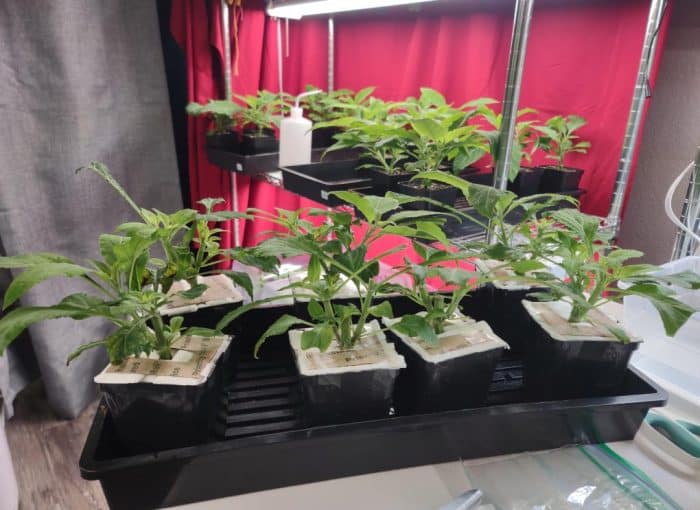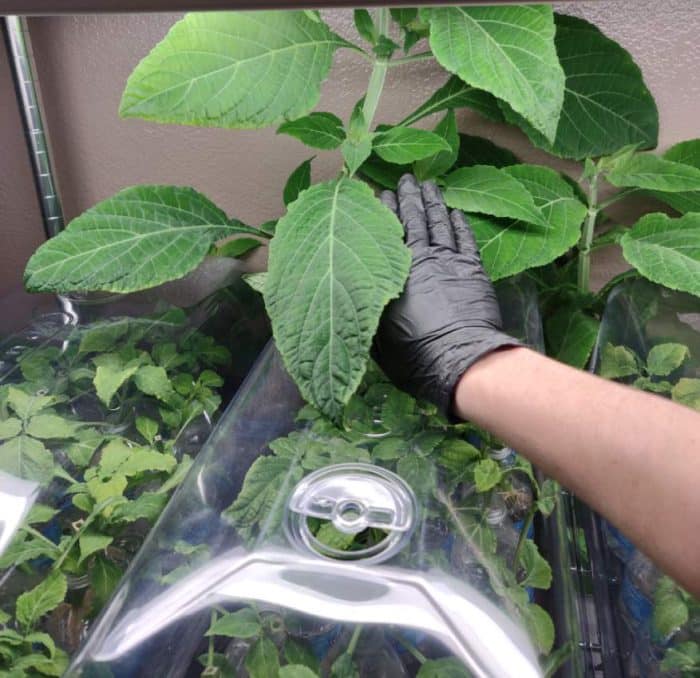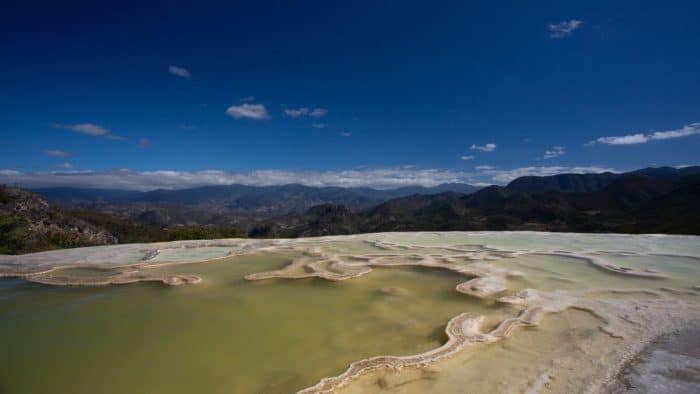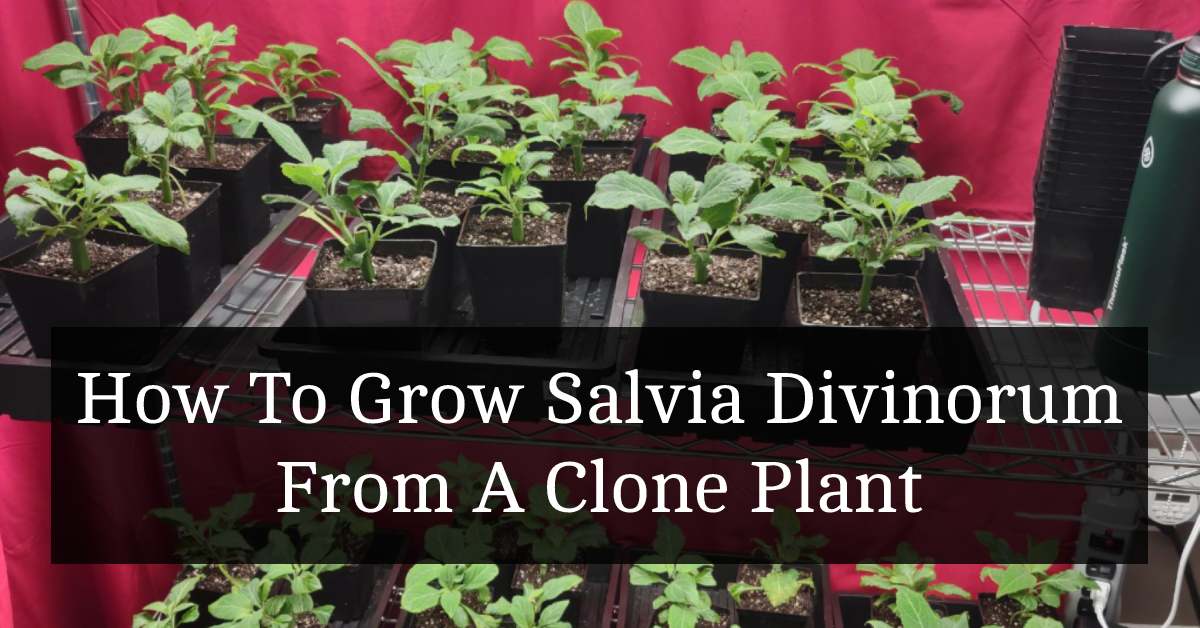Salvia divinorum is a member of the sage family and is native to the cloud forests of Oaxaca, Mexico. It has been traditionally used by Mazatec shamans in religious and healing ceremonies for centuries. In recent years, salvia divinorum has gained popularity among those interested in its psychoactive effects. While salvia divinorum can be grown outdoors in warm climates, it is also possible to cultivate it indoors, even starting from a small clone plant. In this article, we will guide you through the steps for growing salvia divinorum indoors.

Step 1: Obtaining a Salvia Divinorum Clone Plant
The first step in growing salvia divinorum is to obtain a clone plant. You can either purchase a plant from a reputable nursery or acquire a cutting from a friend or online vendor. We are one of the few online vendors that offer quality salvia divinorum plants for sale. When selecting a clone plant, it is important to choose a healthy specimen that has not been exposed to pests or diseases.
Step 2: Preparing the Soil
When preparing soil for growing salvia divinorum indoors, it is important to create a growing medium that is well-draining, nutrient-rich, and slightly acidic. Here are the steps you can follow to prepare the soil for your salvia divinorum plant:
- Choose a high-quality potting soil: Select a high-quality potting soil that is formulated for indoor plants. Look for a soil mix that contains a blend of organic materials, such as peat moss, perlite, and vermiculite.
- Add perlite: Perlite is a volcanic rock that has been heated and expanded to create a lightweight, porous material that improves drainage and aeration. Mix perlite into the potting soil at a ratio of 1:1.
- Adjust the pH: Salvia divinorum prefers slightly acidic soil with a pH range of 5.5 to 6.5. Test the pH of your soil using a pH testing kit, and adjust it as needed using organic soil amendments. Adding sulfur to the soil can help lower the pH, while adding lime can help raise it.
- Add compost: Salvia divinorum benefits from nutrient-rich soil, and adding compost can help provide the plant with the necessary nutrients. Mix in a small amount of compost or well-rotted manure into the soil.
- Avoid using heavy garden soil: Garden soil can be too heavy and compact for indoor plants, and it can lead to poor drainage and root rot. Stick to using a well-draining potting mix to ensure that your salvia divinorum plant has optimal growing conditions.
By following these steps, you can create a soil mix that is ideal for growing salvia divinorum indoors. Remember to water the plant regularly, but be careful not to overwater as this can lead to root rot. Additionally, it’s a good idea to fertilize the plant with a balanced fertilizer during the growing season to help it reach its full potential. With proper care and attention, your salvia divinorum plant can thrive and produce healthy, potent leaves.
Step 3: Planting the Clone
Remove the clone plant from its container and gently loosen the roots. Make a hole in the center of the soil mixture and place the clone in the hole. Cover the roots with soil and lightly press down to secure the plant in place.
Step 4: Watering
Proper watering is crucial for the health and growth of your salvia divinorum plant. Here’s how to water your plant and keep it healthy:
- Watering frequency: Salvia divinorum plants prefer moist but well-draining soil. Water the plant when the top inch of soil feels dry to the touch. During the growing season, which typically runs from spring to early fall, you may need to water your plant once or twice a week. In the winter months, when the plant goes into dormancy, you can reduce the watering frequency to once every two weeks.
- Watering method: When watering your salvia divinorum plant, use a watering can or spray bottle to water the soil around the base of the plant. Avoid getting water on the leaves as this can promote fungal growth and other diseases. Water the plant until water begins to drain out of the bottom of the pot.
- Use filtered or distilled water: Salvia divinorum is sensitive to chemicals found in tap water, such as chlorine and fluoride. To avoid these chemicals, use filtered or distilled water to water your plant.
- Monitor for overwatering: Overwatering can lead to root rot and other diseases. If you notice that the leaves of your salvia divinorum plant are turning yellow or the soil is consistently wet, you may be overwatering. Allow the soil to dry out before watering again.
- Humidity: Salvia divinorum plants prefer a humid environment. To maintain humidity, mist the leaves of your plant once a day with a spray bottle filled with distilled or filtered water.
Overall, watering your salvia divinorum plant is all about balance. Keep the soil moist but not waterlogged, and avoid letting the plant dry out completely. With proper watering, your salvia divinorum plant can grow healthy and strong, producing high-quality leaves for spiritual and medicinal use.
Step 5: Providing Adequate Lighting
When growing salvia divinorum indoors, providing adequate lighting is crucial to the plant’s growth and development. Salvia divinorum requires bright but indirect light to thrive. A south-facing window can provide the necessary light, but in many cases, additional lighting may be necessary, especially during the winter months when daylight hours are shorter.
When selecting artificial lighting for salvia divinorum, it’s important to choose a light source that provides the right spectrum of light. LED grow lights are a good option for providing the optimal light spectrum for salvia divinorum. They produce a full spectrum of light that closely mimics natural sunlight, and they are also energy-efficient and long-lasting.
When positioning LED grow lights for salvia divinorum, it’s important to ensure that the lights are placed at the appropriate distance from the plant. If the lights are too close, they can cause heat stress or even burn the leaves. On the other hand, if the lights are too far away, they may not provide enough light for the plant to grow properly. A good rule of thumb is to position the lights about 12-18 inches above the plant, depending on the intensity of the lights.
In terms of the duration of light, salvia divinorum requires at least 12 hours of light per day. This can be achieved by setting a timer on the grow lights to turn on and off automatically each day. It’s also important to ensure that the plant is receiving a period of darkness each day, as this is necessary for the plant’s overall health and growth.
Overall, providing the appropriate lighting is essential for growing salvia divinorum indoors. With the right spectrum of light, appropriate distance, and duration of light, you can ensure that your salvia divinorum clone plant receives the light it needs to thrive and produce healthy leaves.
Step 6: Maintaining Humidity
Maintaining proper humidity levels is important for growing salvia divinorum indoors as it helps to mimic the plant’s natural environment and promote healthy growth. Here are some steps you can take to maintain humidity for your salvia divinorum plant:
- Use a hygrometer: A hygrometer is a tool used to measure the humidity levels in the air. Purchase a digital hygrometer and place it near your salvia divinorum plant to monitor the humidity levels.
- Group plants together: Grouping plants together can help to increase humidity levels, as the plants release moisture through transpiration. Placing your salvia divinorum plant near other plants in your indoor garden can help to create a more humid environment.
- Use a humidifier: A humidifier is a machine that adds moisture to the air. Adding a small humidifier to your indoor growing space can help to increase humidity levels and provide your salvia divinorum plant with the moisture it needs.
- Mist the leaves: Misting the leaves of your salvia divinorum plant can help to increase humidity levels around the plant. Use a spray bottle to mist the leaves once or twice a day, being careful not to overwater the plant.
- Use a pebble tray: A pebble tray is a shallow dish filled with pebbles and water. Placing your salvia divinorum plant on top of a pebble tray can help to increase humidity levels around the plant as the water evaporates from the pebbles.
- Avoid overwatering: While it’s important to maintain proper humidity levels, it’s also important not to overwater your salvia divinorum plant. Overwatering can lead to root rot and other plant diseases. Be sure to allow the soil to dry out slightly between watering, and avoid leaving the plant sitting in standing water.
By following these steps, you can maintain proper humidity levels for your salvia divinorum plant and help it thrive in an indoor growing environment. Remember to monitor humidity levels regularly and adjust your humidity maintenance methods as needed.

Step 7: Fertilizing
Preparing the right fertilizer is crucial for healthy growth and potency of salvia divinorum. Here’s how to prepare a fertilizer that will provide the nutrients your plant needs to thrive:
- Choose the right type of fertilizer: For salvia divinorum, a balanced, water-soluble fertilizer that contains equal amounts of nitrogen, phosphorus, and potassium (NPK) is ideal. Look for a fertilizer with a ratio of 20-20-20 or 10-10-10.
- Dilute the fertilizer: Always dilute the fertilizer according to the manufacturer’s instructions. Salvia divinorum can be sensitive to overfertilization, so it’s important not to use too much fertilizer.
- Use a watering can or spray bottle: Mix the diluted fertilizer in a watering can or spray bottle, depending on how you plan to apply the fertilizer. Using a watering can, water the soil around the base of the plant with the diluted fertilizer. If using a spray bottle, apply the fertilizer directly to the leaves.
- Fertilize once a month: Salvia divinorum should be fertilized once a month during the growing season, which typically runs from spring to early fall. During the winter months, the plant will go into a period of dormancy, and fertilizer is not necessary.
- Adjust the pH of the soil: Before fertilizing, test the pH of the soil using a pH testing kit. Salvia divinorum prefers slightly acidic soil with a pH range of 5.5 to 6.5. If the pH is too high or too low, adjust it using organic soil amendments, such as sulfur or lime.
Remember to always follow the manufacturer’s instructions when preparing and applying fertilizer to your salvia divinorum plant. Overfertilizing can lead to burnt or damaged leaves, and underfertilizing can result in slow growth and poor potency. With proper fertilization, your salvia divinorum plant can grow healthy and strong, producing high-quality leaves for use in spiritual and medicinal practices.
Step 8: Pruning
Pruning and trimming your salvia divinorum plant is an important part of maintaining its health and promoting proper growth. Here’s how to prune and trim your salvia divinorum plant:
- Prune dead or damaged leaves: Use clean, sharp scissors or pruning shears to remove any dead or damaged leaves from your salvia divinorum plant. Removing these leaves will help to promote healthy growth and prevent disease.
- Pinch off new growth: Pinching off new growth can help to encourage bushier growth and prevent your salvia divinorum plant from becoming too leggy. Pinch off the tips of new growth as soon as they appear.
- Trim back the plant: Salvia divinorum can become tall and leggy, especially when grown indoors. To prevent this, trim back the plant every few months to promote bushier growth. Use clean, sharp scissors or pruning shears to cut the plant back by about one-third of its total height.
- Prune before flowering: Salvia divinorum can produce small, white flowers in the late summer or fall. If you want to harvest the leaves for spiritual or medicinal purposes, it’s important to prune the plant before it begins to flower. This will encourage the plant to produce more leaves rather than focusing its energy on producing flowers.
- Prune sparingly: While pruning and trimming are important for maintaining the health of your salvia divinorum plant, it’s important not to overdo it. Pruning too much or too often can stress the plant and slow its growth.
In terms of frequency, pruning and trimming can be done as needed to maintain the health and shape of the plant. Regularly checking the plant for dead or damaged leaves and pinching off new growth can be done weekly or as needed. Trimming back the plant can be done every few months. Be sure to always use clean, sharp tools when pruning and trimming to prevent disease and damage to the plant.
Step 9: Harvesting
Salvia divinorum can be harvested once the plant reaches maturity, which typically takes about two years. Harvesting involves cutting the stems just above a node, which is where new growth emerges. The leaves can then be dried and used for smoking or brewing into tea.
Step 10: Troubleshooting Common Issues
While salvia divinorum is generally easy to grow, it can be susceptible to a few common issues. Here are some troubleshooting tips:
- Yellowing leaves: This is often a sign of overwatering or nutrient deficiencies. Allow the soil to dry out and adjustthe fertilizer schedule if necessary.
- Leaf drop: This can be caused by low humidity or cold temperatures. Ensure that the plant is kept in a warm, humid environment.
- Pests: Spider mites and whiteflies can be a problem for salvia divinorum. Regularly inspect the plant and treat with neem oil or insecticidal soap if necessary.
- Root rot: This is caused by overwatering or poor drainage. If you suspect root rot, remove the plant from the soil and trim away any affected roots before replanting in fresh soil.
In conclusion, growing salvia divinorum indoors can be a rewarding and enjoyable experience for those interested in this unique plant. By following the steps outlined in this article, you can successfully cultivate a salvia divinorum clone plant, provide it with the right conditions to thrive, and ultimately harvest the leaves for use in a variety of ways. As with any plant, it is important to be patient and attentive to the needs of your salvia divinorum, but with a little effort and care, you can enjoy the benefits of growing this fascinating plant in the comfort of your own home.
Where does salvia divinorum grow at?
Salvia divinorum is native to the cloud forests of the Sierra Mazateca region in Oaxaca, Mexico. This region is located in the southeastern part of Mexico and is known for its high level of biodiversity, with a wide variety of plant and animal species. The plant typically grows in the understory of the cloud forest, which is a dense, humid forest characterized by a high level of precipitation and cool temperatures. The natural habitat of salvia divinorum is a unique and fragile ecosystem that is threatened by deforestation, climate change, and human development. As a result, the plant is considered to be endangered in its natural habitat, and efforts are underway to conserve and protect this important species.
What is the salvia divinorum plant’s natural environment?
The natural environment of salvia divinorum is characterized by high humidity, cool temperatures, and filtered sunlight. The plant typically grows in the understory of cloud forests, which are characterized by dense vegetation and a high level of moisture in the air.
The soil in the natural habitat of salvia divinorum is rich in organic matter and is well-draining. The plant prefers a slightly acidic soil pH, and it can tolerate a wide range of soil types, including sandy, loamy, and clay soils.
In terms of climate, salvia divinorum thrives in regions with a high level of precipitation, especially during the summer months. The plant is able to tolerate low temperatures, but it cannot tolerate frost. The ideal temperature range for salvia divinorum is between 10-25 degrees Celsius, with the plant being able to tolerate temperatures up to 35 degrees Celsius.

Salvia divinorum is also adapted to low light conditions, and it prefers filtered sunlight rather than direct sunlight. In its natural habitat, the plant receives light that has passed through the dense canopy of the forest above it, creating a diffuse, dappled light that is ideal for its growth.
The high level of humidity in the natural habitat of salvia divinorum is also important for its growth and survival. The plant requires a consistent level of moisture in the air to prevent its leaves from drying out, and it is able to absorb moisture through its leaves as well as its roots.
Finally, the natural habitat of salvia divinorum is also characterized by a rich biodiversity of other plant and animal species. The plant is an important part of the ecosystem, providing food and shelter for a variety of animals and insects.
In conclusion, the natural environment of salvia divinorum is a humid, cool, and shaded environment, characterized by a high level of precipitation and a rich biodiversity of other plant and animal species. The plant is adapted to these conditions and is able to thrive in this unique ecosystem. When growing salvia divinorum indoors, it’s important to replicate these conditions as closely as possible to ensure that the plant is able to grow and produce healthy leaves. This includes providing the plant with a cool and humid environment, filtered sunlight, and well-draining soil that is rich in organic matter. By creating the ideal environment for salvia divinorum, you can successfully grow this fascinating plant and enjoy its psychoactive effects in a safe and responsible way.
Sources
- “Salvia divinorum: Effects, Withdrawal & Addiction Symptoms” from DrugAbuse.com
- “How to Grow Salvia Divinorum” from The Third Wave
- “Salvia Divinorum” from Plants of the Gods
- “Growing Salvia divinorum” from Erowid
- “Salvia divinorum: A systematic review of the clinical evidence” from Psychopharmacology
- “Salvia Divinorum: How to Grow and Use It” from The Guardian
- “How to Grow Salvia Divinorum Indoors: A Comprehensive Guide” from The Psychedelic Scientist
- “Salvia divinorum: a brief overview of its pharmacology and psychoactive effects” from Journal of Psychopharmacology
- “Salvia Divinorum Cultivation” from Entheology.com
- “The Salvia Divinorum Grower’s Guide” from SageWisdom.org
- “Salvia Divinorum: Growing and Harvesting” from Zamnesia
- “Salvia Divinorum Guide: Effects, Common Uses, Safety” from American Addiction Centers
- “How to Grow Salvia Divinorum From Cuttings” from Leafly
- “Salvia Divinorum – Indoor Growing Techniques” from Salvia.net
- “Salvia Divinorum: A Comprehensive Guide” from Psychedelic Science Review.



